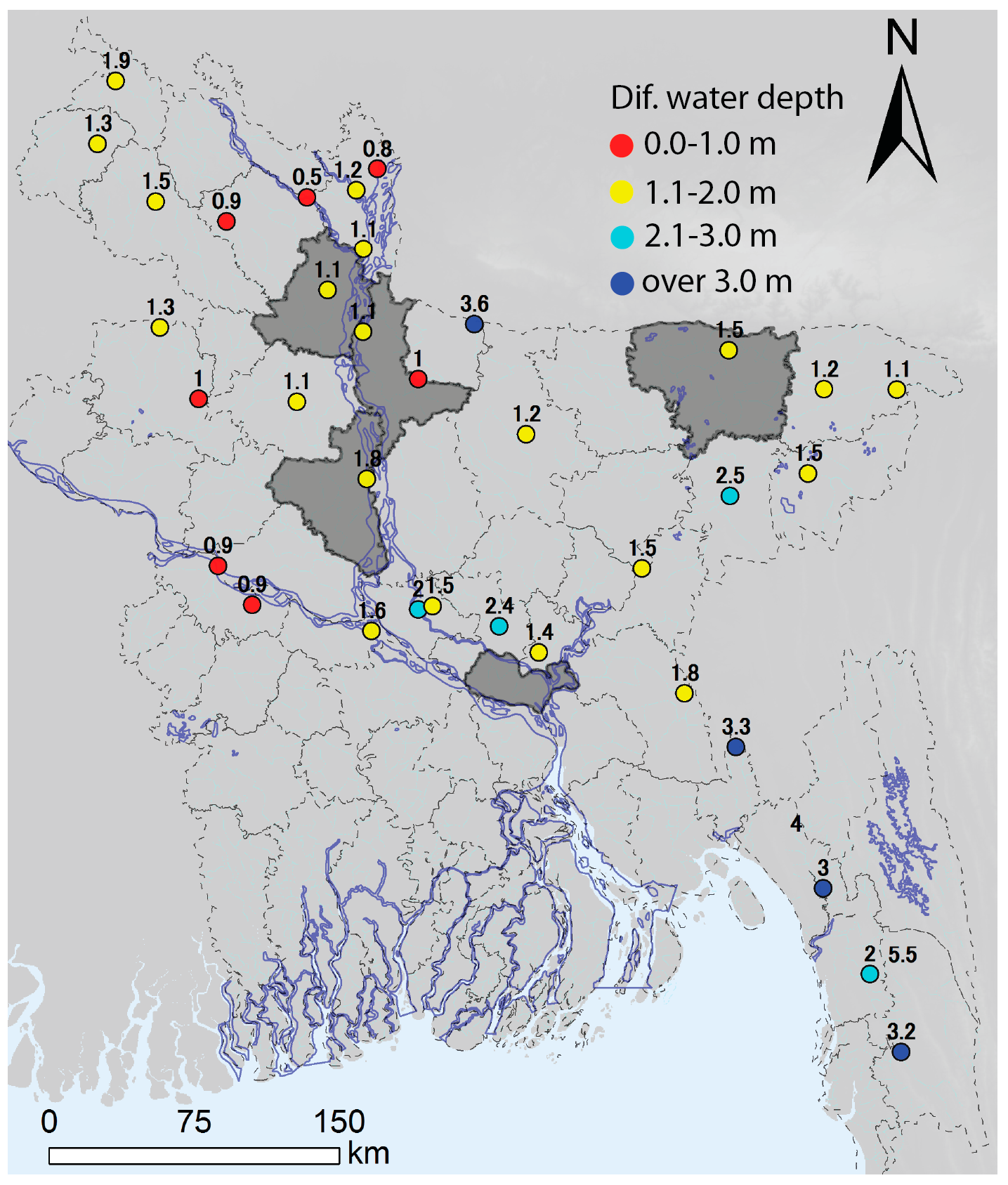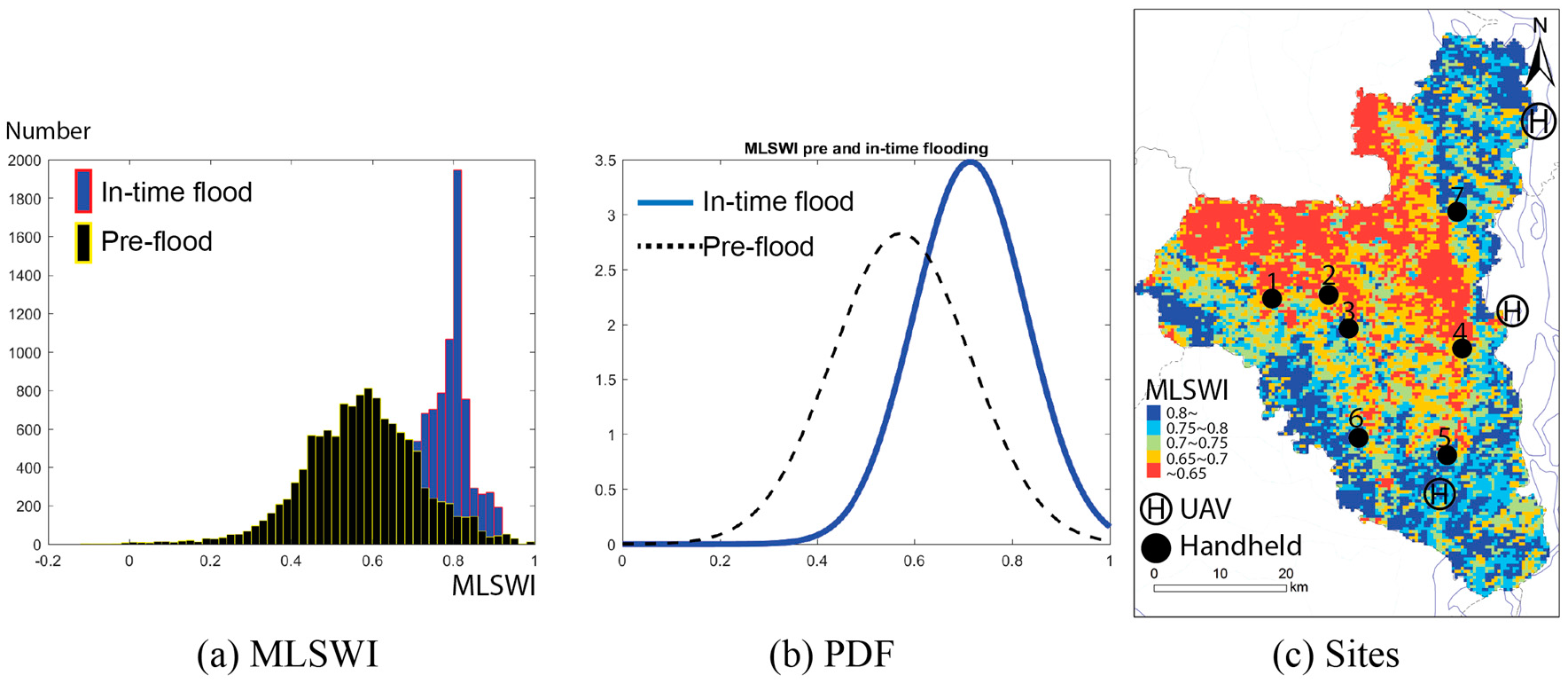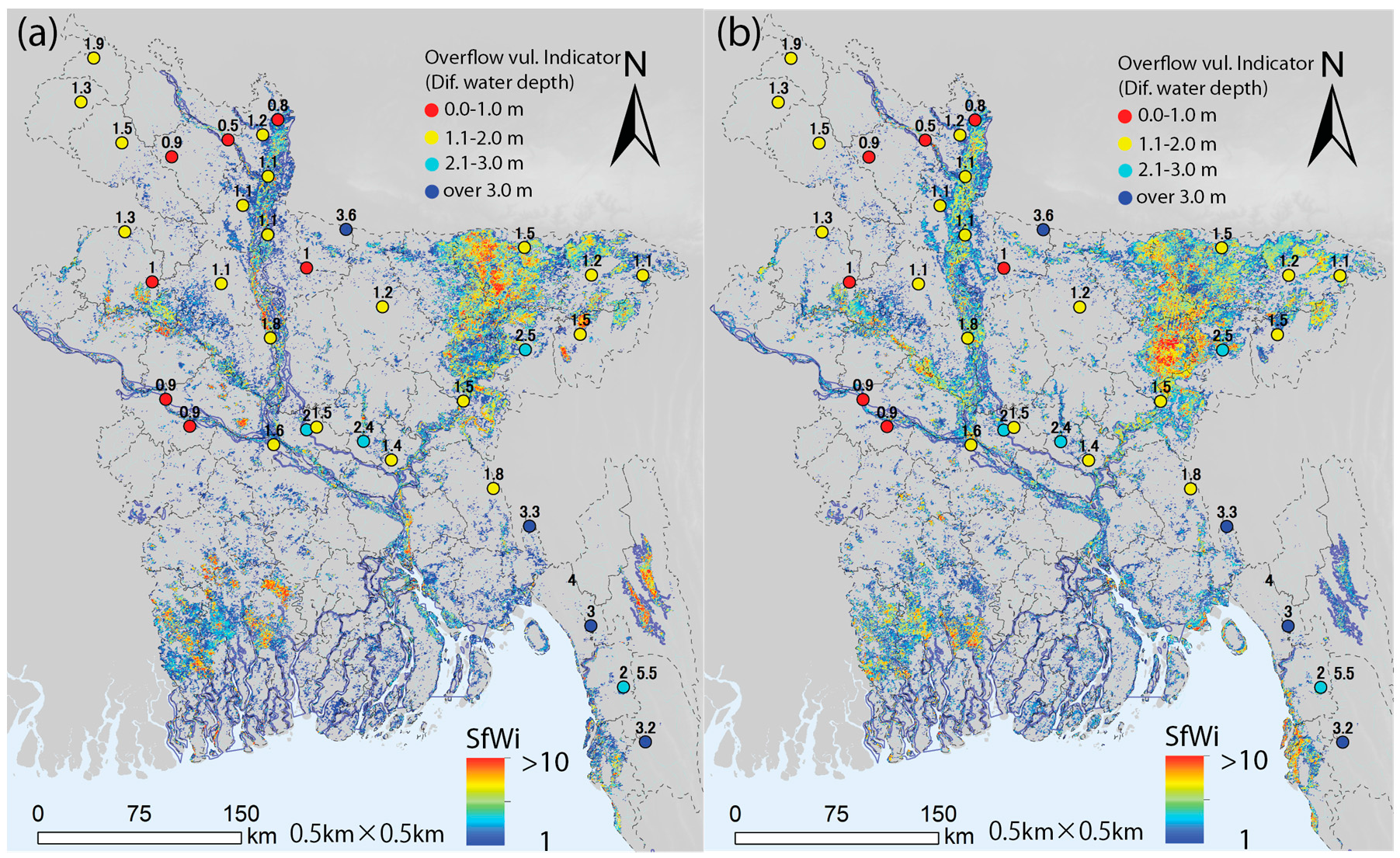Nationwide Flood Monitoring for Disaster Risk Reduction Using Multiple Satellite Data
Abstract
:1. Introduction
2. Materials and Methods
2.1. Data Used
2.2. Nationwide Flood Mapping Framework
2.2.1. National Disaster Monitoring: Scheme A
2.2.2. Dynamic Floodwater Mapping Cycle: Scheme B
2.2.3. Annual Flood Mapping: Scheme C
2.3. Pilot Country: Bangladesh
2.4. Synchronized Floodwater Index
2.4.1. Modified Land Surface Water Index (MLSWI)
2.4.2. Time-Series Synchronized Floodwater Index (SfWi)
3. Results
3.1. Validated Synchronized Floodwater Index
3.1.1. Time-Series MLSWI Coupled with Water Level
3.1.2. In Situ Field Survey
3.2. Nationwide Annual Flood Mapping
4. Discussion
5. Conclusions
Acknowledgments
Author Contributions
Conflicts of Interest
References
- World Meteorological Organization. IPCC’s Fifth Assessment Report (AR5); Climate Change 2014 Synthesis Report; WMO: Geneva, Switzerland, 2014. [Google Scholar]
- The UN Office for Disaster Risk Reduction (UNISDR). Sendai Framework for Disaster Risk Reduction 2015–2030. In Proceedings of the 3rd United Nations World Conference on Disaster Risk Reduction in Sendai of Japan, Geneva, Switzerland, 14–18 March 2015. [Google Scholar]
- United Nations. Sendai Framework for Disaster Risk Reduction 2015–2030; A/CONF.224/L.2; United Nations Office for Disaster Risk Reduction (UNISDR): Geneva, Switzerland, 2015; 32 p. [Google Scholar]
- Kwak, Y.; Iwami, Y. Rapid global flood exposure assessment for extreme river flood risk under climate change. J. Disaster Res. 2016, 11, 1128–1136. [Google Scholar] [CrossRef]
- JPL-NASA. The Advanced Rapid Imaging and Analysis (ARIA) Center for Natural Hazards. Available online: https://aria.jpl.nasa.gov (accessed on 31 January 2014).
- Schumann, G.J.-P. Preface: Remote Sensing in Flood Monitoring and Management. Remote Sens. 2015, 7, 17013–17015. [Google Scholar] [CrossRef]
- Google Earth Engine. Application Programming Interface (API). Available online: https://developers.google.com/earth-engine (accessed on 1 November 2016).
- Xiong, J.; Thenkabail, P.S.; Gumma, M.K.; Teluguntla, P.; Poehnelt, J.; Congalton, R.G.; Yadav, K.; Thau, D. Automated cropland mapping of continental Africa using Google Earth Engine cloud computing. ISPRS J. Photogramm. Remote Sens. 2017, 126, 225–244. [Google Scholar] [CrossRef]
- McFeeters, S.K. The use of the Normalized Difference Water Index (NDWI) in the delineation of open water features. Int. J. Remote Sens. 1996, 17, 1425–1432. [Google Scholar] [CrossRef]
- Gao, B. NDWI—A normalized difference water index for remote sensing of vegetation liquid water from space. Remote Sens. Environ. 1996, 58, 257–266. [Google Scholar] [CrossRef]
- Xiao, X.; Hollinger, D.; Aber, J.D.; Goltz, M.; Davidson, E.A.; Zhang, Q.Y. Satellite-based modeling of gross primary production in an evergreen needle leaf forest. Remote Sens. Environ. 2004, 89, 519–534. [Google Scholar] [CrossRef]
- Chandrasekar, K.; Sesha Sai, M.; Roy, P.; Dwevedi, R. Land Surface Water Index (LSWI) response to rainfall and NDVI using the MODIS Vegetation Index product. Int. J. Remote Sens. 2010, 31, 3987–4005. [Google Scholar] [CrossRef]
- Pinheiro, A.C.T.; Descloitres, J.; Privette, J.L.; Susskind, J.; Iredell, L.; Schmaltz, J. Near-real time retrievals of land surface temperature within the MODIS rapid response system. Remote Sens. Environ. 2007, 106, 326–336. [Google Scholar] [CrossRef]
- Dartmouth Flood Observatory (DFO). Dartmouth Atlas of Global Flood Hazard. 2008. Available online: http://www.dartmouth.edu/~floods/index.html (accessed on 15 April 2012).
- National Aeronautics and Space Administration (NASA). Near Real-Time (NRT) Global MODIS Flood Mapping. 2015. Available online: http://oas.gsfc.nasa.gov/floodmap/ (accessed on 3 January 2015).
- Revilla-Romero, B.; Hirpa, F.A.; del Pozo, J.T.; Salamon, P.; Pappenberg, F.; De Groeve, T. On the Use of Global Flood Forecasts and Satellite-Derived Inundation Maps for Flood Monitoring in Data-Sparse Regions. Remote Sens. 2015, 7, 15702–15728. [Google Scholar] [CrossRef]
- Shumann, G.; Baldassarre, G.; Bates, P. The Utility of Spaceborne Radar to Render Flood Inundation Maps Based on Multialgorithm Ensembles. IEEE Trans. Geosci. Remote Sens. 2009, 47, 2801–2807. [Google Scholar] [CrossRef]
- Kwak, Y.; Park, Y.; Takeuchi, W.; Iwami, Y. A Synchronized Floodwater Index for Flood Risk Mapping using Multiple Satellite Data: A Case Study of 2015 Bangladesh Flood. Presented at JpGU-AGU Joint Meeting, Chiba, Japan, 20–25 May 2017; Available online: https://confit.atlas.jp/guide/event/jpguagu2017/subject/HDS13-03/advanced (accessed on 20 May 2017).
- Schlaffer, S.; Matgen, P.; Hollaus, M.; Wagner, W. Flood detection from multi-temporal SAR data using harmonic analysis and change detection. Int. J. Appl. Earth Obs. GeoInf. 2015, 38, 15–24. [Google Scholar] [CrossRef]
- Bovolo, F.; Bruzzone, L. A detail-preserving scale-driven approach to change detection in multitemporal SAR images. IEEE Trans. Geosci. Remote Sens. 2005, 43, 2963–2972. [Google Scholar] [CrossRef]
- Chapman, B.; McDonald, K.; Shimada, M.; Rosenqvist, A.; Schroeder, R.; Hess, L. Mapping Regional Inundation with Spaceborne L-Band SAR. Remote Sens. 2015, 7, 5440–5470. [Google Scholar] [CrossRef]
- Kwak, Y.; Yorozuya, A.; Iwami, Y. Disaster Risk Reduction using Image Fusion of Optical and SAR data before and after Tsunami Disaster. In Proceedings of the 2016 IEEE Aerospace Conference, Big Sky, MT, USA, 5–12 March 2016; pp. 1–11. [Google Scholar]
- NASA-USGS. The Land Processes Distributed Active Archive Center (LP DAAC). Available online: https://lpdaac.usgs.gov/dataset_discovery/modis/modis_products_table/ (accessed on 31 May 2017).
- Bangladesh Water Development Board (BWDB). Flood Forecasting & Warning Centre (FFWC). 2014. Available online: http://www.ffwc.gov.bd (accessed on 31 May 2017).
- Kwak, Y.J.; Arifuzzanman, B.; Iwami, Y. Prompt Proxy Mapping of Flood Damaged Rice Fields using MODIS-derived Indices. Remote Sens. 2015, 7, 15969–15988. [Google Scholar] [CrossRef]
- Kwak, Y.; Park, J.; Fukami, K. Near real-time flood volume estimating from MODIS time-series imagery in the Indus River basin. IEEE J. Sel. Top. Appl. Earth Obs. Remote Sens. 2014, 7, 578–586. [Google Scholar] [CrossRef]
- Japan Aerospace Exploration Agency (JAXA). Data Access from Earth Observation Data Utilization Promotion Platform. Available online: http://www.eorc.jaxa.jp/ALOS/en/top/doc_top.htm (accessed on 31 May 2017).
- Natsuaki, R.; Motohka, T.; Shimada, M.; Suzuki, S. Burst Misalignment Evaluation for ALOS-2 PALSAR-2 ScanSAR-ScanSAR Interferometry. Remote Sens. 2017, 9, 216. [Google Scholar] [CrossRef]
- The International Charter. International Chart Space and Major Disaster. Available online: https://www.disasterscharter.org (accessed on 31 May 2017).
- Japan Aerospace Exploration Agency (JAXA). Sentinel Asia. Available online: https://sentinel.tksc.jaxa.jp/sentinel2/emobSelect.jsp (accessed on 31 May 2017).
- Japan Meteorological Agency. Himawari-8/9 Spacecraft Overview. Available online: http://www.data.jma.go.jp/mscweb/en/himawari89/space_segment/spsg_spacecraft.html (accessed on 1 September 2016).
- Kwak, Y.; Takeuchi, K.; Fukami, K.; Magome, J. A new approach to flood risk assessment in Asia-Pacific region based on MRI-AGCM outputs. Hydrol. Res. Lett. 2012, 6, 70–75. [Google Scholar] [CrossRef]
- Hofer, T.; Messerli, B. Floods in Bangladesh: History, Dynamics and Rethinking the Role of the Himalayas; United Nations University Press: Tokyo, Japan, 2006. [Google Scholar]
- Bangladesh Water Development Board (BWDB). Annual Flood Report 2007; Flood Forecasting & Warning Centre (FFWC): Dhaka, Bangladesh, 2007.
- Kwak, Y.; Park, J.; Arifuzzaman, B.; Iwami, Y.; Amirul, Md.; Kondoh, A. Rapid Exposure Assessment of Nationwide River Flood for Disaster Risk Reduction. Int. Arch. Photogramm. Remote Sens. Spat. Inf. Sci. 2016, XLI-B8, 1357–1362. [Google Scholar] [CrossRef]
- Kourgialas, N.N.; Karatzas, G.P. A hydro-sedimentary modeling system for flash flood propagation and hazard estimation under different agricultural practices. Nat. Hazards Earth Syst. Sci. 2014, 14, 625–634. [Google Scholar] [CrossRef]
- Moel, H.; Alphen, J.; Aerts, J.C.J.H. Flood maps in Europe—Methods, availability and use. Nat. Hazards Earth Syst. Sci. 2009, 9, 289–301. [Google Scholar] [CrossRef]
- Alphen, J.; Passchier, R. Atlas of Flood Maps. Examples from 19 European Countries, USA and Japan, 2007. Ministry of Transport, Public Works and Water Management: Hague, The Netherlands. Available online: http://ec.europa.eu/environment/water/flood_risk/flood_atlas/index.htm (accessed on 1 May 2017).





| Dataset | Contents | Used Band | Resolution (Spatial/Time) |
|---|---|---|---|
| MODIS (MOD09A1) 1 | Land surface reflectance | Band 2 & 7 | 500 m/eight-day |
| MODIS (MOD11A2) 1 | Land surface temperature | 1000 m/eight-day | |
| Water level 2 | Meter | - | -/one day |
| ALOS-2 3 | Backscattering coefficient | HH | 100 m/one day |
| HIMAWARI 8 4 | Shortwave-IR | Band 5 & 6 | 2000 m/10 min |
| Return Period (Year) | Inundated Area (%, km2) | |
|---|---|---|
| 2 | 20 | 29,900 |
| 5 | 30 | 43,000 |
| 10 | 37 | 55,000 |
| 20 | 43 | 62,000 |
| 50 | 52 | 75,000 |
| 100 | Over 60 | 89,000 |
| The average of inundated area: 2-year return period = 20% | ||
| The 2007 flood: 20-year return period = 43% | ||
| The 1998 flood: 100-year return period = over 68% | ||
© 2017 by the author. Licensee MDPI, Basel, Switzerland. This article is an open access article distributed under the terms and conditions of the Creative Commons Attribution (CC BY) license (http://creativecommons.org/licenses/by/4.0/).
Share and Cite
Kwak, Y.-j. Nationwide Flood Monitoring for Disaster Risk Reduction Using Multiple Satellite Data. ISPRS Int. J. Geo-Inf. 2017, 6, 203. https://doi.org/10.3390/ijgi6070203
Kwak Y-j. Nationwide Flood Monitoring for Disaster Risk Reduction Using Multiple Satellite Data. ISPRS International Journal of Geo-Information. 2017; 6(7):203. https://doi.org/10.3390/ijgi6070203
Chicago/Turabian StyleKwak, Young-joo. 2017. "Nationwide Flood Monitoring for Disaster Risk Reduction Using Multiple Satellite Data" ISPRS International Journal of Geo-Information 6, no. 7: 203. https://doi.org/10.3390/ijgi6070203





